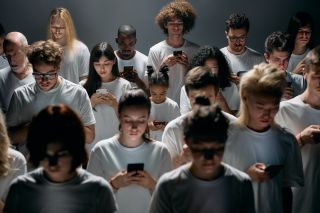Social Networking
Social Media and Herd Mentality
Online content activates brain circuitry in ways you need to understand.
Updated September 8, 2023 Reviewed by Davia Sills
Key points
- Positive interactions (e.g., “likes”) can activate reward circuitry in the brain.
- Constant activation of reward circuitry can drive compulsive behaviors.
- Compulsively seeking likes on social media can push individuals to post things just to appease a group.
- Without other outlets, one can become consumed by the need to appease the group.

Social media has profoundly altered the relationship between individuals and media by making media consumption a dynamic process rather than a passive one. Social media platforms create open forums where consumers can engage directly with the creator of the media or with other consumers. Platforms also respond to what consumers explicitly and implicitly like—the former through the push of a button, the latter by measuring the time an individual spends acknowledging specific content, even if they do not openly declare that they like it. The more one likes certain content, the more the platform responds to curate content that keeps the consumer engaged.
Social media also allows individuals to be not only consumers but producers of content. Initially, this content was simple. One shared their thoughts or experiences with a limited social network and received a modest amount of “likes” or social rewards. In rare cases, one would create something so popular that it spread like a virus—i.e., it went viral.
Recognizing that viral content was being viewed by millions of people, especially with the advent of smartphones, advertisers began working with content creators to create sponsored content specifically designed to go viral or to serve as clickbait or to simply catch someone’s attention long enough to “live rent-free in their head,” as the saying goes. Monetizing social media content led to the creation of an influencer economy that is now estimated to be worth $13.8 billion and comprised of 50 million people.
Social media has also changed how we express ourselves politically.
Dopamine, Likes, and Virality
Dopamine is a neurotransmitter that influences behaviors like eating, having sex, and engaging in positive social interactions by activating reward networks in the brain. Dopamine is also released following the use of drugs like cocaine and alcohol, which contributes to their addictive qualities. While a positive social interaction may not produce the same level of reward as cocaine, it still activates dopaminergic networks and impacts the relationship between the behavior and the sense of reward. This is known as positive reinforcement.
Whereas in the past, positive social interactions required engaging with others in the real world, positive social interactions through social media can be messages from friends, affirmations from strangers, or simply “likes.” Receiving notifications on your phone of messages, “likes” of something you did, or requests to be your friend activates the reward networks within the brain, making you feel good and, most importantly, motivating you to keep interfacing with the platform. This is true for casual users as well as individuals who are fully immersed in digital social networks, and it is why social media has such an influence on our lives.
Viral content has also become a part of our existence. While there is no consensus as to what specifically makes a piece of content viral, viewing such material activates reward networks in the brain. They either evoke an emotional response (positive or negative) or entertain us when we see them. These same reward networks are activated when we share content that generates a response from others. To guarantee such a response and activation of the reward network, the safest bet is to post content that is already viral or content that conforms to the mores of a given in-group.
When In-Group Becomes Groupthink
The phrase “herd mentality” has Orwellian undertones similar to “groupthink” or the more explicitly Orwellian “doublethink,” but it is rarely the result of manipulation by some sinister authoritarian group. Instead, it’s what happens when groups of individuals are influenced by the majority of a specified group to which they belong (i.e., the in-group). Unfortunately, “herd mentality” is just as capable of celebrating the virtues of the in-group as it is of demonizing the supposed wickedness of the people who fall outside of this group or belong to a different group entirely (i.e., the out-group). This is true with politics, religion, and even choice of pet (cat people vs. dog people). It can also lead individuals to only listen to positive information about their in-group of choice and ignore any criticism, thereby creating an echo chamber.
To be clear, the notion that social media creates echo chambers or causes society to become polarized is misguided. Polarization in American politics dates back to the split between Federalists and Anti-Federalists, and echo chambers have existed for as long as people have had opinions. What social media has changed is that it’s made participation in in-group versus out-group dynamics more active and less passive for a large number of people. Moreover, the more that one’s persona on social media has increasingly become integral to one’s identity, the more ardently many have sought validation from others within the in-group via social media.
This has been particularly destructive in the world of politics. Given the performative nature of social media, expressing allegiance to the in-group takes the form of liking in-group posts, repeating shibboleths, denouncing “the other,” or expressing or manufacturing outrage over something that “they” did or are trying to do. In practice, the easiest means of satiating the reward networks comes from mindlessly acquiescing to the wisdom of the in-group or expressing hostility to the other in novel ways. The former leads to demands of in-group purity, while the latter seeks to showcase how the other is corrupt or hypocritical, amplifying political polarization and leading individuals to regard the other not merely as a person with differing views but as something evil.
While there is no easy way to resolve this issue and make partisan discussion on social media less toxic, one possible solution is to encourage people to cultivate identities that are not dominated entirely by politics. Adding dimensions to one’s character through creative or athletic pursuits, hobbies, and social activities involving friends and family can help individuals discover rewarding experiences outside social media and politics.




